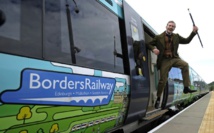On Wednesday the queen will become Britain's longest-reigning monarch, surpassing her great-grandmother Queen Victoria rule of 63 years and 216 days.
As Britain and remnants of the British Empire mark the momentous occasion, the record-breaker herself will be boarding a train at Edinburgh's Waverly Station.
Abandoned in 1969, the newly-reopened line will take the 89-year-old monarch and husband Prince Philip to the border village of Tweedbank, following a legendary 48km (29 miles) route.
After a lengthy campaign, the Borders Railway will run its first service for 46 years on Sunday, three days ahead of the queen's arrival.
The Waverley Route, named after a series of novels by poet Scott, is a source of fierce pride for locals.
"The Borders Railway has become a symbol of the golden age for Scotland Railways and it will be the vehicle for a new prosperity for the communities it serves," said Keith Brown, the Scottish Secretary for Infrastructure.
Although primarily intended for use by locals, the line has the potential to become a tourist attraction thanks to the works of Scott -- author of historic novels Ivanhoe and Rob Roy -- and the rugged landscape that it spans.
The reopening is also seen as righting a historical wrong committed by the central government in London, which ruled in the 1960s that the line was unprofitable.
Nationalist sentiment is currently running high north of the border, a year after an historic vote on self-determination.
Although the nationalists lost the independence referendum, they scored 44.6 percent of the vote, a share unthinkable just months before the poll.
The referendum, which was closely followed by media around the world, helped shine the spotlight on Scotland, according to Mike Cantlay, chairman of the Visit Scotland tourism agency.
"We are a small country, we make up 0.5 percent of world tourism, so you have to punch above your weight on the global stage to be noticed," he said.
Richard Bath, editor of the magazine Scottish Field, said the referendum had sparked "a far greater interest in Scotland around the world".
"Scotland has many clear national symbols -- kilts, bagpipes, tartan, whisky, golf -- that help people around the world differentiate the country from the rest of the UK," he said.
As well as the referendum, sporting events such as golf's Ryder Cup and the Commonwealth Games helped boost visitor numbers to Scotland to 15.5 million in 2014, 700,000 more than in 2013, according to Visit Scotland.
--------------------------------------------------------------------------------------------------------------
As Britain and remnants of the British Empire mark the momentous occasion, the record-breaker herself will be boarding a train at Edinburgh's Waverly Station.
Abandoned in 1969, the newly-reopened line will take the 89-year-old monarch and husband Prince Philip to the border village of Tweedbank, following a legendary 48km (29 miles) route.
After a lengthy campaign, the Borders Railway will run its first service for 46 years on Sunday, three days ahead of the queen's arrival.
The Waverley Route, named after a series of novels by poet Scott, is a source of fierce pride for locals.
"The Borders Railway has become a symbol of the golden age for Scotland Railways and it will be the vehicle for a new prosperity for the communities it serves," said Keith Brown, the Scottish Secretary for Infrastructure.
Although primarily intended for use by locals, the line has the potential to become a tourist attraction thanks to the works of Scott -- author of historic novels Ivanhoe and Rob Roy -- and the rugged landscape that it spans.
The reopening is also seen as righting a historical wrong committed by the central government in London, which ruled in the 1960s that the line was unprofitable.
Nationalist sentiment is currently running high north of the border, a year after an historic vote on self-determination.
Although the nationalists lost the independence referendum, they scored 44.6 percent of the vote, a share unthinkable just months before the poll.
The referendum, which was closely followed by media around the world, helped shine the spotlight on Scotland, according to Mike Cantlay, chairman of the Visit Scotland tourism agency.
"We are a small country, we make up 0.5 percent of world tourism, so you have to punch above your weight on the global stage to be noticed," he said.
Richard Bath, editor of the magazine Scottish Field, said the referendum had sparked "a far greater interest in Scotland around the world".
"Scotland has many clear national symbols -- kilts, bagpipes, tartan, whisky, golf -- that help people around the world differentiate the country from the rest of the UK," he said.
As well as the referendum, sporting events such as golf's Ryder Cup and the Commonwealth Games helped boost visitor numbers to Scotland to 15.5 million in 2014, 700,000 more than in 2013, according to Visit Scotland.
--------------------------------------------------------------------------------------------------------------









 Home
Home Politics
Politics











